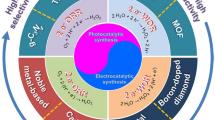Summary
The oxidation of H2O2 by [W(CN)8]3− has been studied in aqueous media between pH 7.87 and 12.10 using both conventional and stopped-flow spectrophotometry. The reaction proceeds without generation of free radicals. The experimental overall rate law, \({{{\text{d[W(CN)}}_{\text{8}}^{{\text{4 - }}} ]} \mathord{\left/ {\vphantom {{{\text{d[W(CN)}}_{\text{8}}^{{\text{4 - }}} ]} {{\text{d}}t = 2(k_s [{\text{H}}_{\text{2}} {\text{O}}_{\text{2}} ])[{\text{W(CN)}}_{\text{8}}^{{\text{3 - }}} ]}}} \right. \kern-\nulldelimiterspace} {{\text{d}}t = 2(k_s [{\text{H}}_{\text{2}} {\text{O}}_{\text{2}} ])[{\text{W(CN)}}_{\text{8}}^{{\text{3 - }}} ]}}\), strongly suggests two types of mechanisms. The first pathway, characterized by the pH-dependent rate constant k s, given by \({{2k_s = (k_{\text{a}} + k_{\text{b}} K_5 [{\text{H}}^{\text{ + }} ]^{ - 1} )} \mathord{\left/ {\vphantom {{2k_s = (k_{\text{a}} + k_{\text{b}} K_5 [{\text{H}}^{\text{ + }} ]^{ - 1} )} {[1 + K_5 [{\text{H}}^{\text{ + }} ]^{ - 1} )(}}} \right. \kern-\nulldelimiterspace} {[1 + K_5 [{\text{H}}^{\text{ + }} ]^{ - 1} )(}}1 + K_{{\text{a1}}} [{\text{H}}^{\text{ + }} ]^{ - 1} )^{{1 \mathord{\left/ {\vphantom {1 2}} \right. \kern-\nulldelimiterspace} 2}} ]\), involves the formation of [W(CN)8· H2O2]3−, [W(CN)8· H2O2·W(CN)8]6− and [W(CN)8· HO]3− intermediates in rapid pre-equilibria steps, and is followed by a one-electron transfer step involving [W(CN)8·HO]3− (k a) and its conjugate base [W(CN)8·O]4− (k b). At 25 °C, I = 0.20 m (NaCl), the rate constant \(k_{\text{a}} = (8.0 \pm 0.9) \times 10^{ - 3} {\text{M}}^{{{\text{1}} \mathord{\left/ {\vphantom {{\text{1}} {\text{2}}}} \right. \kern-\nulldelimiterspace} {\text{2}}}} {\text{S}}^{{\text{ - 1}}} \) with ΔH ‡a =40±6kJmol−1 and ΔS ‡a =−151±22JK−1mol−1; the rate constant \(k_b = 0.22 \pm 0.03{\text{M}}^{{{{\text{ - 1}}} \mathord{\left/ {\vphantom {{{\text{ - 1}}} {\text{2}}}} \right. \kern-\nulldelimiterspace} {\text{2}}}} {\text{S}}^{{\text{ - 1}}} \) with ΔH ‡b =36±1kJmol−1 and ΔS ‡b =−136±2JK−1mol−1 at 25 °C, I = 0.20 m (NaCl); the acid dissociation constant of [W(CN)8·HO]3−, K 5 =(5.9±1.7)×10−10 m, with \(\Delta H_{K_5 }^ = 18 \pm 5{\text{kJ mol}}^{{\text{ - 1}}} \) and \(\Delta S_{K_5 }^ = - 117 \pm 23{\text{JK}}^{{\text{ - 1}}} {\text{mol}}^{{\text{ - 1}}} \) is the first acid dissociation constant of H2O2. The second pathway, with rate constant, k f, involves the formation of [W(CN)8· HO2]4− and is followed by a formal two-electron redox process with [W(CN)8]3−. The pH-dependent rate constant, k f, is given by \({{2k_{\text{f}} = 2k_{\text{7}} } \mathord{\left/ {\vphantom {{2k_{\text{f}} = 2k_{\text{7}} } {(1 + K_{{\text{a1}}}^{{\text{ - 1}}} [{\text{H}}^{\text{ + }} ])}}} \right. \kern-\nulldelimiterspace} {(1 + K_{{\text{a1}}}^{{\text{ - 1}}} [{\text{H}}^{\text{ + }} ])}}\). The rate constant k 7 =23±6m −1 s −1 with \(\Delta H_{K_7 }^\ddag = 9 \pm 2{\text{kJ mol}}^{{\text{ - 1}}} \) and \(\Delta S_{K_7 }^\ddag = - 188 \pm 7{\text{JK}}^{{\text{ - 1}}} {\text{ mol}}^{{\text{ - 1}}} \) at 25°C, I = 0.20 m (NaCl).
Similar content being viewed by others
References
B. Sieklucka, Progr. React. Kinet., 15, 175 (1989); and refs cited therein.
J. G. Leipoldt, S. S. Basson and A. Roodt, Adv. Inorg. Chem., 40, 241 (1993); and refs cited therein.
A. Samotus and J. Szklarzewicz, Coord. Chem. Rev., 125, 63 (1993).
B. Sieklucka, Inorg. Chim. Acta, 186, 179 (1991).
B. Sieklucka and A. Samotus, J. Photochem. Photobiol. A: Chem., 74, 115 (1993); and refs cited therein.
B. Sieklucka, A. Kanas and A. Samotus, Transition Met. Chem., 7, 131 (1982).
M. Bogdanov, R. Gryboś, A. Samotus and K. Bogolitsyn, Transition Met. Chem., 18, 599 (1993).
B. Sieklucka, M. Bogdanov, R. Gryboś and A. Samotus in G. Ondrejovič and A. Sirota (Eds), Contributions to Development of Coordination Chemistry, Slovak Technical University Press, Brastislava, 1993, p. 373.
A. Kanas and A. Samotus, in Proc. 9th Conf. Coord. Chem., Smolenice, Czechoslovakia 1983, p. 163.
J. Sobkowski, Rocz. Chem., 43, 1729 (1969).
D. Zehavi and J. Rabani, J. Phys. Chem., 76, 3703 (1972).
A. Samotus, Rocz. Chem., 47, 265 (1973).
G. Evans and N. Uri, Trans. Faraday. Soc., 45, 224 (1949).
F. J. Kristine, C. R. Johnson, S. O'Donnel and R. E. Shepherd, Inorg. Chem., 19, 2280 (1980).
N. W. Alcock, A. Samotus and J. Szklarzewicz, J. Chem. Soc., Dalton Trans., 885 (1993).
J. Rabani and M. S. Matheson, J. Am. Chem. Soc., 86, 3175 (1964).
R. G. Wilkins, Kinetics and Mechanism of Reactions of Transition Metal Complexes, 2nd Edit., VCH Weinheim, 1991.
J. Szklarzewicz, A. Samotus and A. Kanas, Polyhedron, 5, 1733 (1986).
J. O. M. Bockris and L. F. Oldfield, Trans. Faraday Soc., 51, 249 (1955).
Author information
Authors and Affiliations
Rights and permissions
About this article
Cite this article
Sieklucka, B., Samotus, A. Kinetics and mechanism of the oxidation of hydrogen peroxide by the octacyanotungstate(V) ion in alkaline aqueous media. Transition Met Chem 21, 226–230 (1996). https://doi.org/10.1007/BF00165972
Received:
Accepted:
Issue Date:
DOI: https://doi.org/10.1007/BF00165972




